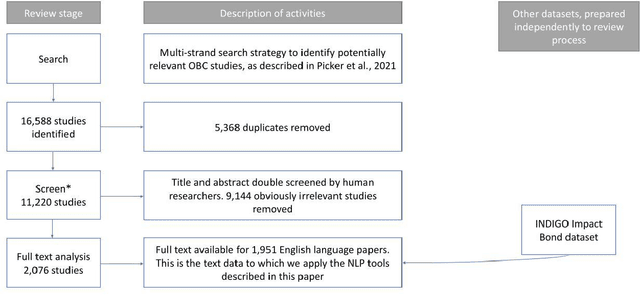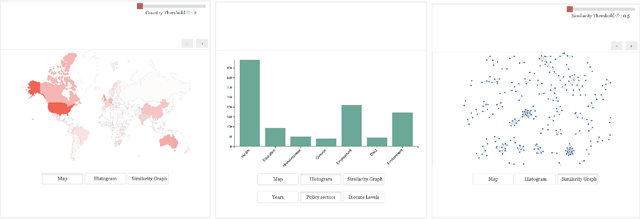Eleanor Carter
Machine Learning Information Retrieval and Summarisation to Support Systematic Review on Outcomes Based Contracting
Dec 11, 2024Abstract:As academic literature proliferates, traditional review methods are increasingly challenged by the sheer volume and diversity of available research. This article presents a study that aims to address these challenges by enhancing the efficiency and scope of systematic reviews in the social sciences through advanced machine learning (ML) and natural language processing (NLP) tools. In particular, we focus on automating stages within the systematic reviewing process that are time-intensive and repetitive for human annotators and which lend themselves to immediate scalability through tools such as information retrieval and summarisation guided by expert advice. The article concludes with a summary of lessons learnt regarding the integrated approach towards systematic reviews and future directions for improvement, including explainability.
PitRSDNet: Predicting Intra-operative Remaining Surgery Duration in Endoscopic Pituitary Surgery
Sep 25, 2024



Abstract:Accurate intra-operative Remaining Surgery Duration (RSD) predictions allow for anaesthetists to more accurately decide when to administer anaesthetic agents and drugs, as well as to notify hospital staff to send in the next patient. Therefore RSD plays an important role in improving patient care and minimising surgical theatre costs via efficient scheduling. In endoscopic pituitary surgery, it is uniquely challenging due to variable workflow sequences with a selection of optional steps contributing to high variability in surgery duration. This paper presents PitRSDNet for predicting RSD during pituitary surgery, a spatio-temporal neural network model that learns from historical data focusing on workflow sequences. PitRSDNet integrates workflow knowledge into RSD prediction in two forms: 1) multi-task learning for concurrently predicting step and RSD; and 2) incorporating prior steps as context in temporal learning and inference. PitRSDNet is trained and evaluated on a new endoscopic pituitary surgery dataset with 88 videos to show competitive performance improvements over previous statistical and machine learning methods. The findings also highlight how PitRSDNet improve RSD precision on outlier cases utilising the knowledge of prior steps.
SyROCCo: Enhancing Systematic Reviews using Machine Learning
Jun 24, 2024



Abstract:The sheer number of research outputs published every year makes systematic reviewing increasingly time- and resource-intensive. This paper explores the use of machine learning techniques to help navigate the systematic review process. ML has previously been used to reliably 'screen' articles for review - that is, identify relevant articles based on reviewers' inclusion criteria. The application of ML techniques to subsequent stages of a review, however, such as data extraction and evidence mapping, is in its infancy. We therefore set out to develop a series of tools that would assist in the profiling and analysis of 1,952 publications on the theme of 'outcomes-based contracting'. Tools were developed for the following tasks: assign publications into 'policy area' categories; identify and extract key information for evidence mapping, such as organisations, laws, and geographical information; connect the evidence base to an existing dataset on the same topic; and identify subgroups of articles that may share thematic content. An interactive tool using these techniques and a public dataset with their outputs have been released. Our results demonstrate the utility of ML techniques to enhance evidence accessibility and analysis within the systematic review processes. These efforts show promise in potentially yielding substantial efficiencies for future systematic reviewing and for broadening their analytical scope. Our work suggests that there may be implications for the ease with which policymakers and practitioners can access evidence. While ML techniques seem poised to play a significant role in bridging the gap between research and policy by offering innovative ways of gathering, accessing, and analysing data from systematic reviews, we also highlight their current limitations and the need to exercise caution in their application, particularly given the potential for errors and biases.
 Add to Chrome
Add to Chrome Add to Firefox
Add to Firefox Add to Edge
Add to Edge